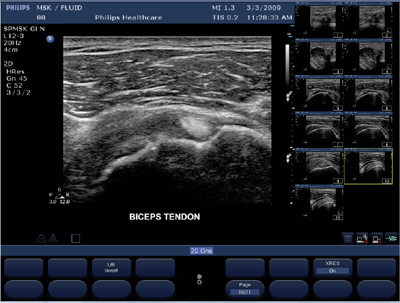Mainstream manufacturers embrace hand-carried ultrasound
Miniaturization gives portable units functions once available only in cart-based systems.
The hand-carried ultrasound market over the last few years has been dominated by three companies. Early leaders SonoSite, GE, and Zonare accounted for more than 85% of the overall revenues generated by sales of compact sonographic units in 2007.
Well, move over, Big Three, as two mainstream radiology players enter the field. Philips and Toshiba are marketing high-end general-purpose hand-carried products that can perform routine radiology and cardiology scans in virtually any setting. Philips' CX50 and Toshiba's Viamo are laptop-sized ultrasound systems that were launched in Europe in March and will be displayed for the U.S. audience at the upcoming RSNA meeting.
The entry of the two major manufacturers speaks to the steady growth of the hand-carried ultrasound sector. Global revenues from compact sonography systems grew by 42% to $565 million in 2007, according to the second annual hand-carried ultrasound report by Klein Biomedical Consultants.
Future potential is huge. The forecast is that compact ultrasound will become a billion-dollar market in just the 10 years, said Jeff Green, senior manager for ultrasound, Toshiba American Medical Systems.
Technological advancements are making portable ultrasound more widely accepted by clinicians. Initial compact units were fine for triage or image-guided procedures, but they didn't rise to the diagnostic level, said Jim Brown, marketing and product manager for Philips portable ultrasound systems.
Improved, diagnostic-quality images, longer battery life, and better tissue penetration are attracting increasing numbers of customers.
"We've improved over the years so overall image quality on hand-carried units is about the same as that of the console," said Al Lojweski, global general manager for GE's cardiovascular ultrasound division. "The advanced features-the 4D-may not be there, but basic 2D, B mode, color Doppler technology in compact systems is equivalent to a system you'd find in the ultrasound lab."
Speed and ease of use are also factors. Physicians who in the past, would have had to wait for the results of a scan or learn how to operate sophisticated machinery can now diagnose patients practically as they come in the door.
"A physician can do an ultrasound to look for free fluid in the abdomen and make a decision in two minutes without having to wait for an ultrasound tech to get there," said Dave Willis, vice president of competitive strategy and innovation at SonoSite. "Algorithms automatically make changes, which speeds up exam time and gives good images so physicians can move from one patient to the next without figuring out a bunch of controls."
As a result, almost every clinical department is using portable ultrasound, including anesthesiology for nerve blocks, radiology, cardiology, intensive and critical care, and the emergency department. SonoSite, in fact, sells to 20 different medical specialties, said Anne M. Bugge, vice president of corporate communications and demand generation for SonoSite.
A flurry of new releases this year is offering clinicians more choices. Zonare is now shipping the z.one ultra sp, a full-featured, cart-based system that can be converted into a premium compact system.
SonoSite is selling the latest addition to its hand-carried product line internationally and is awaiting FDA approval for U.S. sales. The NanoMaxx is a six-pound point-of-care system based on SonoSite's fourth-generation Turbo technology and offers advanced algorithms as well as a fluid-resistant user interface.
The 2.0 release of Siemens' portable Acuson P50 is providing electrophysiologists and interventional cardiologists with real-time, diagnostic quality images as well as Doppler blood flow information. The new release also has 256 beam-forming channels for improved imaging quality as well as SieClear multiview spatial compounding and SieVision speckle reduction.

GE's Venue 40, first shown in May and formally unveiled in September, is a flat-screen, tablet-type hand-carried ultrasound unit. It has a base for docking or can be mounted on a wall or the ceiling. The Venue 40 can be used for guiding vascular access, needle biopsies, or interventional ablations as well as examining patients in critical or intensive care units or the emergency department.
The undeniable draw of portability has been married to top-notch image performance.
"Miniaturizing the ultrasound console at first made it much easier for sonographers and physicians to do exams in places where space was limited-physicians' offices, ER bays, or the OR," Lojweski said. "Giving performance and portability is stimulating a new interest in the marketplace."
The Reading Room: Racial and Ethnic Minorities, Cancer Screenings, and COVID-19
November 3rd 2020In this podcast episode, Dr. Shalom Kalnicki, from Montefiore and Albert Einstein College of Medicine, discusses the disparities minority patients face with cancer screenings and what can be done to increase access during the pandemic.
Can Ultrasound-Based Radiomics Enhance Differentiation of HER2 Breast Cancer?
March 11th 2025Multicenter research revealed that a combined model of clinical factors and ultrasound-based radiomics exhibited greater than a 23 percent higher per patient-level accuracy rate for identifying HER2 breast cancer than a clinical model.